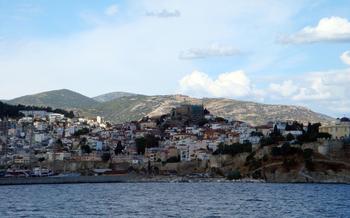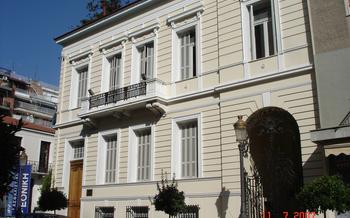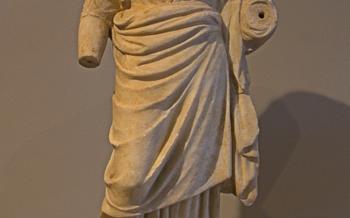
Cave of Alistrati
- The Cave of Alistrati: An Enchanting Underground Realm
- Unraveling the Cave's Geological History
- Exploring the Cave's Archaeological Significance
- Witnessing the Cave's Natural Wonders
- Delving into the Cave's Cultural Significance
- Planning Your Visit to the Cave of Alistrati
- Recommended Time to Visit
- Essential Packing Tips
- Safety Precautions
- Nearby Attractions and Activities
- Accommodation and Dining Options
- Transportation Options
- Budget and Costs
- Accessibility for Visitors with Disabilities
- Insider Tip: Unveiling the Hidden Secrets
The Cave of Alistrati: An Enchanting Underground Realm
Nestled in the heart of Greece's Serres region, the Cave of Alistrati invites you on an unforgettable journey into the depths of the earth. This natural wonder boasts a mesmerizing array of geological formations, showcasing the intricate artistry of nature's sculpting hand. As you explore its vast chambers, you'll witness awe-inspiring stalactites and stalagmites that adorn the cave walls like sparkling chandeliers, creating a breathtaking spectacle that leaves visitors in awe.
The cave's geological wonders are complemented by its rich historical significance. Archaeological discoveries within the cave have shed light on ancient civilizations that once inhabited the region, offering glimpses into their lives and customs. The cave's cultural importance is further enhanced by its mythological associations, as it is believed to be connected to the myth of Orpheus and Eurydice, adding an enchanting layer to its allure.
Unraveling the Cave's Geological History
The Cave of Alistrati owes its existence to the relentless work of water erosion over millions of years. This natural sculpting process has resulted in a labyrinth of tunnels, chambers, and galleries adorned with a diverse array of geological formations. The cave's limestone bedrock, composed primarily of calcium carbonate, has been dissolved by acidic groundwater, creating the intricate and awe-inspiring features that we see today.
Among the most notable geological wonders of the cave are its unique rock formations. Stalactites, which hang from the ceiling like icicles, and stalagmites, which rise from the floor like pillars, are formed by the continuous dripping of mineral-rich water. Over time, these formations can merge to create columns, creating a surreal and otherworldly landscape.
The cave is also home to a variety of fossils and minerals, providing valuable insights into its geological past. Fossils of ancient marine creatures, such as corals and shells, offer evidence of the region's submerged history. The presence of minerals like calcite and gypsum further adds to the scientific significance of the cave, shedding light on the complex geological processes that have shaped this subterranean realm.
Conservation efforts play a crucial role in preserving the cave's natural beauty and geological integrity. Strict regulations and monitoring ensure that the delicate formations are not damaged or disturbed by human activities. The cave's protected status highlights its importance as a unique and irreplaceable geological heritage site.
Exploring the Cave's Archaeological Significance
The Cave of Alistrati boasts a rich archaeological significance, with a history that dates back to prehistoric times. Excavations within the cave have unearthed a wealth of ancient artifacts, including tools, weapons, and pottery, providing valuable insights into the lives of past inhabitants. These discoveries suggest that the cave served as a shelter or dwelling place for humans as early as the Neolithic period.
Beyond the physical remains, the cave is also adorned with cave paintings and engravings, offering a glimpse into the artistic expressions and symbolic beliefs of ancient civilizations. These artworks depict various animals, human figures, and abstract symbols, providing a unique window into the minds and imaginations of our ancestors.
Ongoing archaeological research continues to shed light on the cave's past. Excavations and studies conducted by teams of archaeologists have uncovered additional artifacts and insights, helping to piece together the complex history of human occupation and activity within the cave. These ongoing efforts contribute to our understanding of the cultural and historical significance of the Cave of Alistrati.
Witnessing the Cave's Natural Wonders
Stalactites and stalagmites:
The Cave of Alistrati boasts a mesmerizing display of stalactites and stalagmites, nature's whimsical sculptures formed over millennia by the patient drip of water seeping through the limestone rock. Stalactites, like frozen teardrops, hang from the ceiling, while stalagmites, their mirror images, rise from the cave floor. Their intricate shapes and diverse colors, ranging from white to honey-gold, create a captivating spectacle that leaves visitors in awe.
Crystal formations:
The cave's walls shimmer with glittering crystal formations, adding an extra layer of enchantment to its subterranean realm. These crystals, formed by the precipitation of minerals from water, catch and reflect the light, creating a magical ambiance. The most common crystals found in the Cave of Alistrati are calcite, aragonite, and gypsum, each contributing to the cave's unique and captivating visual appeal.
Subterranean river:
A gentle subterranean river meanders through the cave, its soothing murmurs adding to the serenity of the environment. This underground waterway, fed by rainwater seeping through the porous limestone, has played a crucial role in shaping the cave's intricate features. Its constant flow has eroded the rock, creating tunnels, chambers, and the mesmerizing formations that adorn the cave's interior.
Light and shadow effects:
The interplay of light and shadow within the cave creates a dynamic and ever-changing spectacle. Natural light filters through the cave's entrance, casting ethereal beams that illuminate the stalactites and stalagmites, accentuating their intricate forms. As the day progresses, the shifting sunlight creates a kaleidoscope of colors and patterns, transforming the cave into a living canvas of natural art.
Delving into the Cave's Cultural Significance
The Cave of Alistrati holds a significant place in Greek mythology and folklore, weaving a tapestry of ancient tales and legends. According to Greek mythology, the cave is associated with the myth of Orpheus and Eurydice, a tragic love story involving a musician and his beloved wife. It is believed that Orpheus descended into the underworld through this cave in an attempt to rescue Eurydice from the clutches of Hades, the god of the underworld.
Beyond mythology, the cave has inspired numerous local folklore and legends that have been passed down through generations. These stories often revolve around mythical creatures, hidden treasures, and supernatural occurrences associated with the cave. The local people hold these tales dear, as they offer a glimpse into the rich cultural heritage of the region.
The cave's cultural significance extends to the realm of art and literature. It has served as a muse for artists, writers, and musicians, inspiring creative works that capture the cave's beauty, mystery, and historical significance. Paintings, poems, and musical compositions have been dedicated to the cave, showcasing its profound impact on the local culture.
In modern times, the cave continues to be a focal point for cultural events and festivals. Throughout the year, various cultural activities, such as concerts, exhibitions, and theatrical performances, are held in or around the cave, attracting visitors from near and far. These events celebrate the cave's unique atmosphere and provide a platform for local artists and performers to showcase their talents.
Planning Your Visit to the Cave of Alistrati
The Cave of Alistrati is conveniently located in the region of Serres, in northern Greece. To reach the cave from major cities like Thessaloniki, you can take a scenic drive or utilize public transportation options such as buses or trains. Guided tours are available to enhance your experience and provide insights into the cave's history and geology. It is recommended to book your tour in advance, especially during peak tourist seasons, to secure your spot and avoid any disappointment. The tour duration typically lasts around 45 minutes to an hour, and the difficulty level is suitable for most visitors. The cave is equipped with essential facilities such as parking, restrooms, and a gift shop for souvenirs and refreshments.
Recommended Time to Visit
When is the Best Time to Visit the Cave of Alistrati?
The best time to visit the Cave of Alistrati depends on your personal preferences and priorities. Here are some factors to consider:
-
Weather conditions: The cave maintains a relatively stable temperature throughout the year, but it can be chilly, especially during the winter months. If you are sensitive to cold weather, it is advisable to visit during the warmer months, from April to October.
-
Tourist crowds: The cave is a popular tourist destination, and it can get crowded during the peak season, from July to August. If you prefer a more peaceful and intimate experience, consider visiting during the shoulder months, from April to June or September to October.
-
Off-season benefits: Visiting during the off-season (November to March) has its advantages. You will encounter fewer crowds, potentially lower prices, and a more relaxed atmosphere. Additionally, the cave's natural beauty can be even more striking in the winter, when the surrounding landscape is blanketed in snow.
-
Special events and festivals: Throughout the year, the cave hosts special events and festivals that offer unique experiences. For example, during the summer months, there are often concerts and theatrical performances held inside the cave. Check the cave's official website or local tourism offices for information on upcoming events.
Essential Packing Tips
Packing for a visit to the Cave of Alistrati requires careful consideration to ensure a comfortable and enjoyable experience. Here are some essential tips to keep in mind:
Comfortable clothing and footwear: Choose breathable, comfortable clothing that allows for freedom of movement. Avoid wearing anything too tight or restrictive. Sturdy, comfortable footwear with good traction is essential for navigating the uneven surfaces and slippery spots within the cave.
Camera and lighting: Bring a camera to capture the stunning beauty of the cave's formations. Consider carrying a flashlight or headlamp for better visibility in dimly lit areas.
Snacks and drinks: Pack snacks and drinks to sustain yourself during the tour, as there are no food outlets inside the cave. Choose lightweight, non-perishable items that won't create a mess.
Personal belongings: Keep your belongings secure in a small backpack or bag that you can carry comfortably throughout the tour. Avoid bringing large bags or bulky items that may hinder your movement.
Safety Precautions
Exploring the Cave of Alistrati requires adherence to safety guidelines for a safe and enjoyable experience. Visitors should pay heed to the instructions provided by tour guides and signage within the cave. Slippery surfaces and uneven paths demand cautious footsteps to prevent accidents. Respect for the environment is paramount, as touching or damaging the cave's natural formations is strictly prohibited. Individuals with health conditions, such as claustrophobia or respiratory issues, should carefully consider their suitability for the cave's environment. Prioritizing safety ensures a memorable and hassle-free visit to this natural wonder.
Nearby Attractions and Activities
The Cave of Alistrati is not just an isolated natural wonder; it is surrounded by a rich tapestry of historical, cultural, and natural attractions that will enrich your visit. Embrace the opportunity to explore nearby archaeological sites, such as the ancient city of Amphipolis, and unravel the region's intriguing past. Discover other natural wonders in the area, including cascading waterfalls, serene lakes, and picturesque hiking trails that invite you to immerse yourself in the beauty of the Greek landscape. Indulge in the local cuisine, savoring traditional Greek dishes and regional specialties in nearby villages and towns, where you can experience the warmth and hospitality of the local people. Plan day trips or excursions to other captivating destinations within reach, such as the vibrant city of Thessaloniki or the stunning Halkidiki peninsula, each offering its own unique charm and experiences.
Accommodation and Dining Options
When planning your visit to the Cave of Alistrati, you'll have a range of accommodation and dining options to choose from. For a comfortable stay, consider booking a room at one of the nearby hotels or guesthouses. These accommodations offer a variety of amenities to suit different budgets and preferences.
To immerse yourself in the local culinary scene, explore the traditional Greek restaurants in the surrounding villages and towns. Indulge in delicious dishes prepared with fresh, local ingredients, and savor the authentic flavors of the region.
For a more rustic experience, pack a picnic lunch and head to one of the scenic spots around the cave. Enjoy a leisurely meal surrounded by nature's beauty, creating lasting memories of your visit.
If you prefer the convenience of preparing your own meals, consider staying in a self-catering accommodation. Several apartments and villas in the area are equipped with kitchens, allowing you to cook using local ingredients and enjoy the flexibility of dining at your own pace.
Transportation Options
Reaching the Cave of Alistrati is a breeze, with various transportation options available to suit your needs and preferences. For those relying on public transportation, buses and trains connect nearby cities and towns to the cave, offering a convenient and budget-friendly option.
If you prefer the flexibility of exploring at your own pace, consider renting a car. This allows you to not only visit the cave but also venture into the surrounding areas, discovering hidden gems and picturesque landscapes.
Organized tours are another excellent option, especially if you want a hassle-free experience. These tours typically include transportation to and from the cave, as well as guided tours and visits to other attractions in the region.
For those who prefer a more personalized experience, taxis and ride-sharing services are readily available. This option offers door-to-door convenience, allowing you to tailor your journey to your specific needs and schedule.
Budget and Costs
Visiting the Cave of Alistrati is an affordable experience that offers excellent value for money. The entrance fee for adults is set at a reasonable rate, and concessions are available for students, seniors, and children. Guided tours are highly recommended to enhance your understanding of the cave's history and geology. The cost of a guided tour is typically included in the entrance fee, but it's essential to check in advance to avoid any surprises.
Additional expenses to consider during your visit include transportation, accommodation, and food. If you're traveling on a budget, there are several ways to save money. Opt for public transportation or carpooling to reach the cave. Budget-friendly accommodation options, such as hostels or guesthouses, are available in the nearby towns. Pack your own snacks and drinks to avoid spending on food inside the cave.
To make the most of your budget, consider visiting during the off-season when there are fewer crowds and potential discounts on entrance fees and guided tours. It's also worth checking for package deals or tour operators that offer combined tickets for multiple attractions in the area, providing cost savings and a comprehensive sightseeing experience.
Accessibility for Visitors with Disabilities
The Cave of Alistrati is committed to providing an inclusive and accessible experience for visitors with disabilities. Several features are in place to ensure a comfortable and enjoyable visit for all.
-
Accessibility Features: The cave is equipped with ramps and elevators, making it easy for visitors with mobility impairments to navigate the site. Designated parking spaces are also available near the entrance.
-
Assistance and Support: Trained staff is available to provide assistance and support to visitors with disabilities. They can offer guidance, directions, and assistance with any special needs or requirements.
-
Advance Planning: To ensure a smooth and seamless visit, it is advisable for visitors with disabilities to plan in advance. Contacting the cave's management or tour operators beforehand allows them to make any necessary arrangements and accommodations.
-
Alternative Experiences: For visitors who may not be able to physically enter the cave, alternative experiences are available. Virtual tours offer a comprehensive exploration of the cave's interior, while tactile exhibits provide a sensory experience for visitors with visual impairments.
Insider Tip: Unveiling the Hidden Secrets
The Cave of Alistrati holds many hidden secrets waiting to be discovered by curious explorers. Ask your guide about hidden corners or lesser-known areas within the cave that offer unique perspectives and photo opportunities. Capture the best shots of the cave's formations and natural beauty by learning photography tips from experienced guides or photographers.
Local guides often have a wealth of knowledge and stories about the cave that may not be commonly known. Engage with them to uncover hidden secrets and gain a deeper understanding of the cave's history, geology, and cultural significance.
To fully immerse yourself in the region's charm, explore off-the-beaten-path activities or attractions near the cave. Visit nearby villages, indulge in local cuisine, and discover hidden gems that showcase the authentic character of the area.





